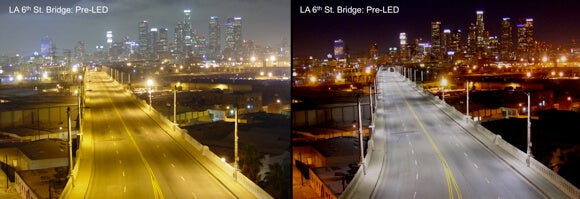New York City to Replace 250,000 Street Lights With LEDs by 2017
By 2017, the streets of New York will be bathed in the glow of microchips, Mayor Mike Bloomberg recently announced. The city plans to replace 250,000 high-pressure sodium street lights with LEDs. Bloomberg called the move a “no-brainer.”

Share
By 2017, the streets of New York will be bathed in a clear, white semiconductor glow, Mayor Mike Bloomberg recently announced. The city plans to replace 250,000 high-pressure sodium streetlights with LEDs. Bloomberg called the move a “no-brainer.”
New York’s streetlights currently produce a baleful orange glow by electrocuting vaporized sodium atoms. Sodium bulbs have been around since the 1930s and are commonly used in cities. But LEDs last longer (20 years) than sodium bulbs (6 years), tend to be more efficient, and give off cleaner, more illuminating light.
New York has already gone to LEDs on select streets in Manhattan, Brooklyn, and in Central Park. The $76.5 million project will replace streetlights in waves of 80,000 and, and if projections bear out, save $14 million in maintenance and energy annually.
New York's transportation commissioner, Janette Sadik-Khan, said in a press conference, “These 250,000 new lights will redefine our roadways and neighborhoods, bringing in clearer, whiter and more attractive lights to our 6,000 miles of streets and 12,000 miles of sidewalks.”
Bloomberg and company say New York City's LED project is the world’s biggest—but it’s hardly the first.
Los Angeles, for example, recently finished replacing just over 141,000 streetlights with LEDs. The city says savings have so far outstripped projections (63% cost reduction compared to the forecast 40%), and light pollution is much reduced because LEDs can be better directed, preventing unintended light leakage.
Other US cities upgrading to LED streetlights include Seattle, Las Vegas, Austin, and San Antonio, among others. Buenos Aires will soon install some 100,000 LED streetlights. More may follow. According to Navigant Research, shipments of LED streetlights are set to rise from 3 million in 2012 to 17 million in 2020.
Be Part of the Future
Sign up to receive top stories about groundbreaking technologies and visionary thinkers from SingularityHub.


Beyond energy and maintenance savings, LEDs can also make city lighting smarter. Senior Navigant research analyst, Eric Woods, said, “LED lamps allow for better dimming control than standard street lights, and their electronics allow for easy integration of control nodes."
Woods thinks finance may be the biggest hindrance to wider adoption. Upfront costs of projects can stymy cash-strapped municipalities.
Accelerating adoption of LED lighting in cities is mirrored at home. Though LEDs currently make up less than 10% of the residential market, they're the fastest growing segment, and IMS Research predicts they'll account for 66% of the market by 2020.
Current offerings include dumb, relatively cheap, and long-lived bulbs from Cree ($8) or smarter bulbs from LIFX and Philips. LIFX and the Philips Hue are more costly, but using a smartphone or tablet, you can dim them, turn them on or off remotely, and even change their color—all that without updating a single switch or wire.
Jason is editorial director at SingularityHub. He researched and wrote about finance and economics before moving on to science and technology. He's curious about pretty much everything, but especially loves learning about and sharing big ideas and advances in artificial intelligence, computing, robotics, biotech, neuroscience, and space.
Related Articles

Single Injection Transforms the Immune System Into a Cancer-Killing Machine

This Light-Powered AI Chip Is 100x Faster Than a Top Nvidia GPU

This Week’s Awesome Tech Stories From Around the Web (Through December 20)
What we’re reading


